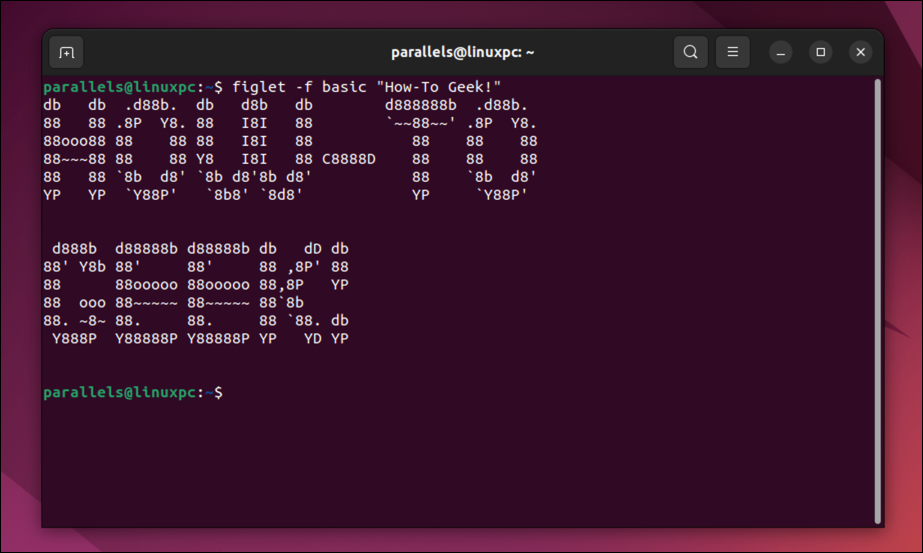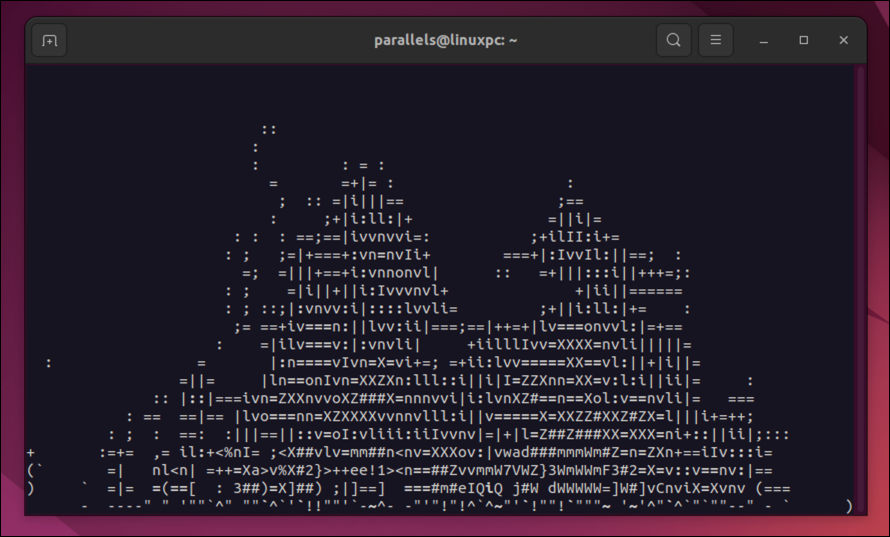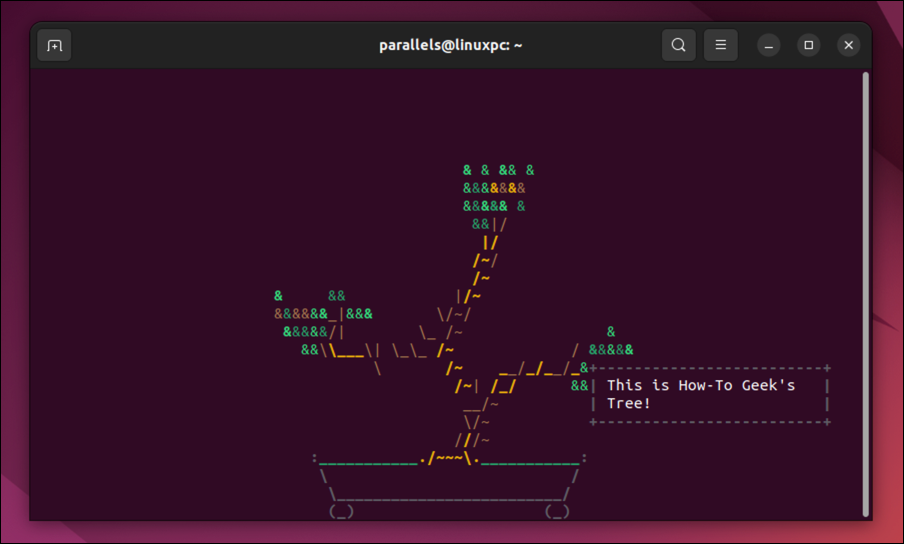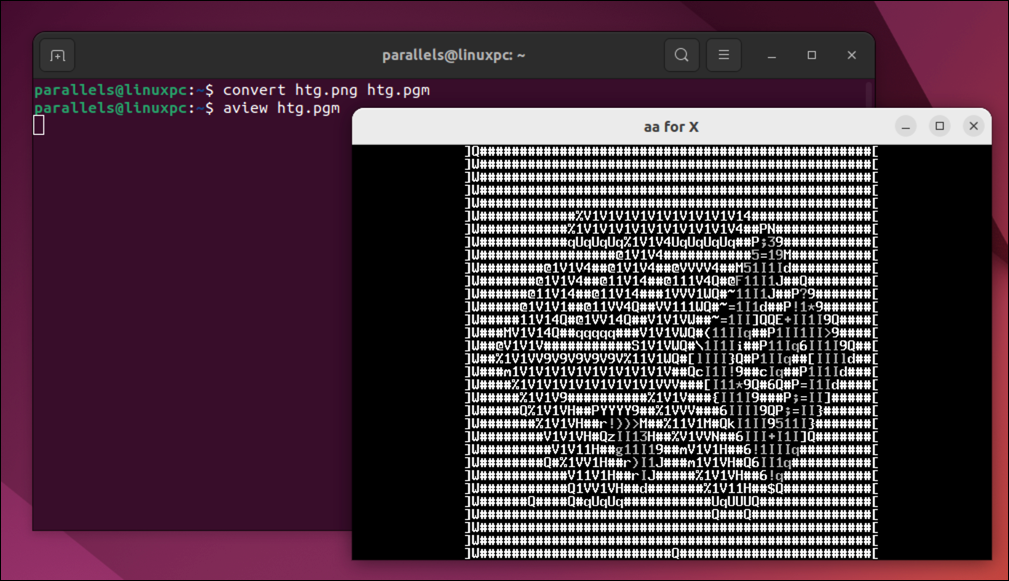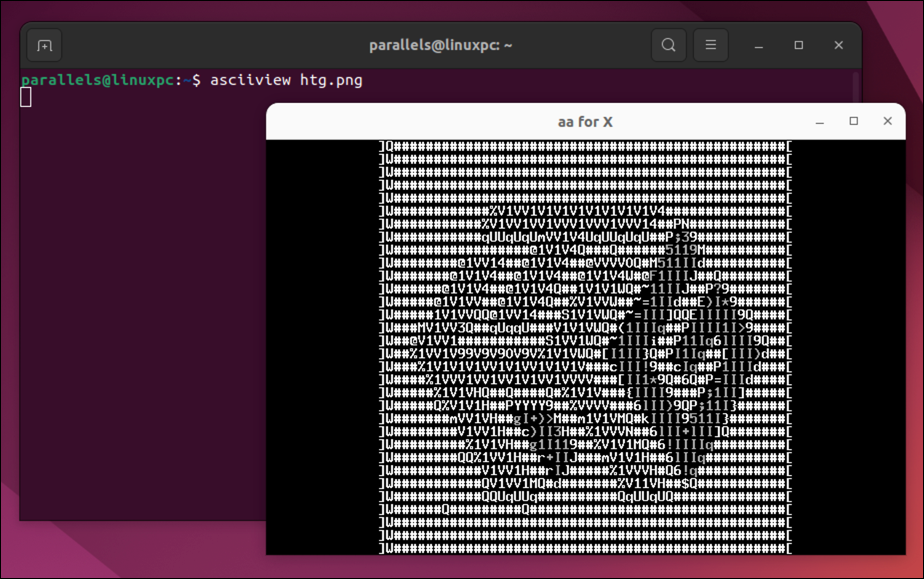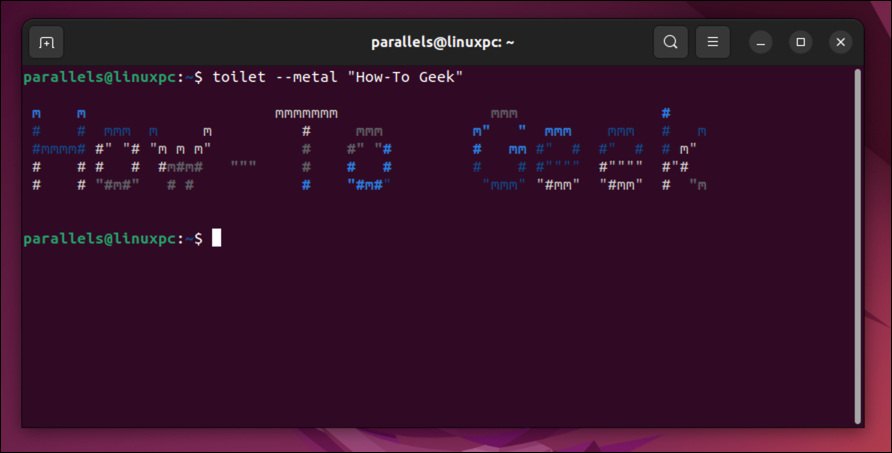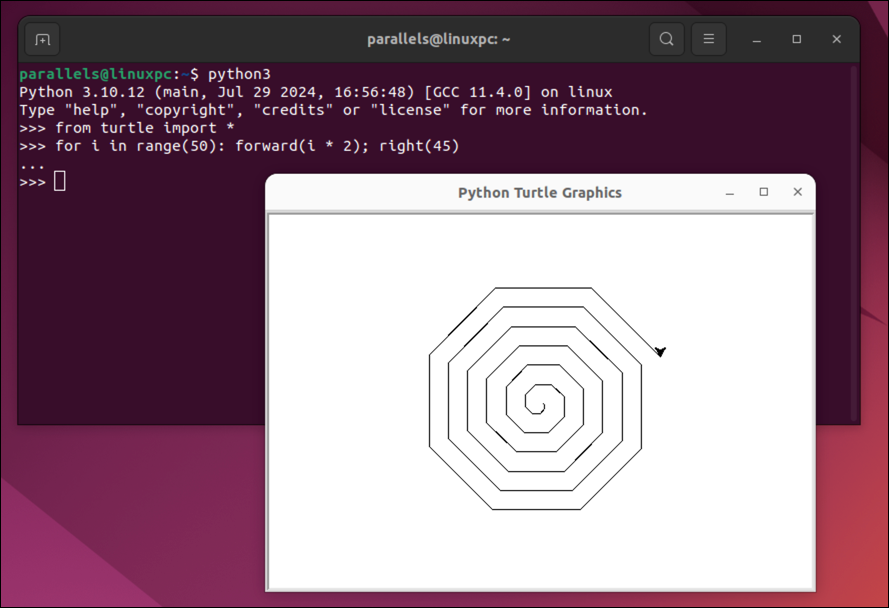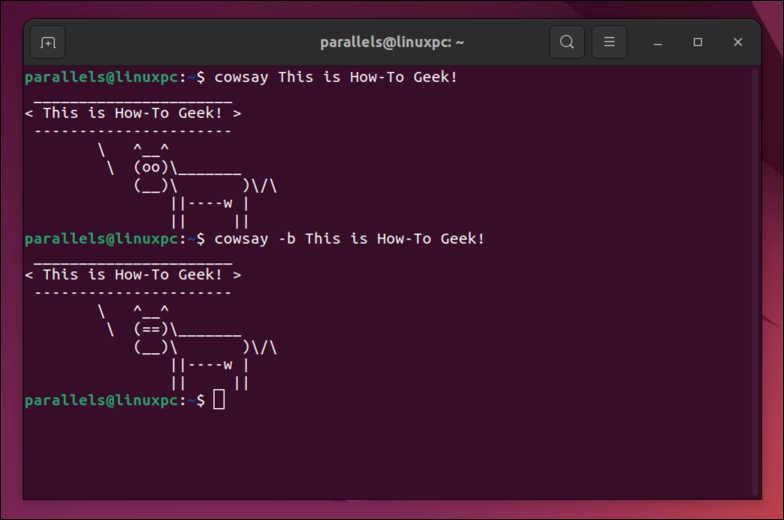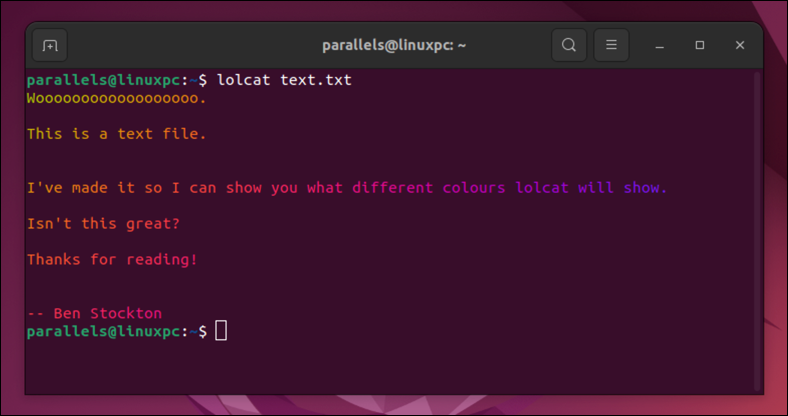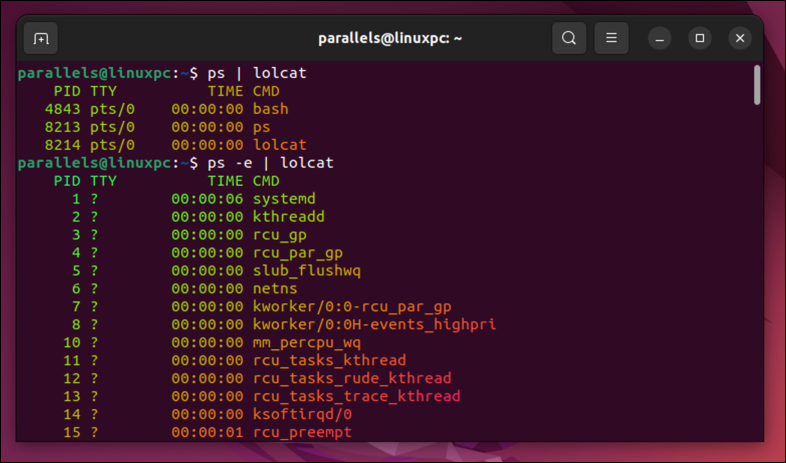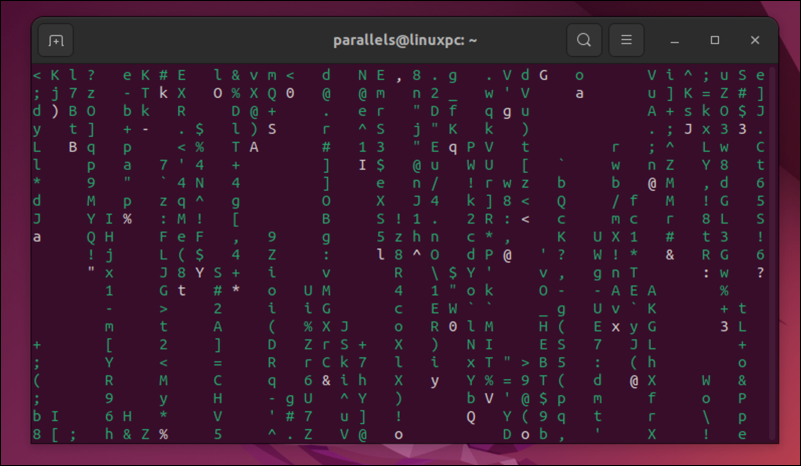On Linux, art is whatever you want it to be. It could be displaying ASCII-converted images or creating your own elaborate 3D-line sketches using turtle graphics. It can even be a bonsai tree growing in your terminal window. If you’re on Linux, you can try out some of these commands for yourself.
1 FIGlet
The terminal is text based, so ASCII art is often the best way to be creative within it. FIGlet is a command you can run in the Linux terminal that allows you to draw 3D-style ASCII text art using a huge library of different font files.
The FIGlet website has a number of these font files for you to download. To use them, download the font files to your Linux PC, then from the same directory in the terminal, type:
figlet -f font text
Replace font with the name of the font file and text with the text you want to print.
FIGlet is available in the default apt repository for Ubuntu and Debian-based systems, so just type sudo apt install figlet in the terminal to install it.
2 aafire
No need to get chilly in the terminal. If you want a bit of ASCII art to run on a second screen, you might want to run the aafire command. It’s actually a test command included in the aalib library, which is itself a high-level ASCII art library used by other applications.
Running aafire -driver curses will fill your terminal window with a simulated ASCII open fire. If you set up your terminal colors correctly, you’ll make it look pretty fiery, too.
You’ll need to install the aalib library first. Just run sudo apt install aalib to do this on an Ubuntu or Debian-based system.
3 cbonsai
A real bonsai tree takes years of dedication and growth. I don’t have time for that, and neither do you, so let’s just run cbonsai in the terminal and watch this fun little Linux command grow one for us.
You can run it in screensaver mode using this command:
cbonsai -S
You can add a custom message to the tree using:
cbonsai -m message
Or, watch it grow for yourself using the cbonsai -l command.
Install it using sudo apt install cbonsai on Debian or Ubuntu systems. You can also run man cbonsai to view a full list of available flags first, with the ability to change the number of branches and the size of the tree.
4 aview & asciiview
You can’t usually view an image from the terminal window itself. It’s text-based, so that’s usually impossible. Thanks to aview, though, you don’t need to, because you can turn any standard image file into an ASCII equivalent that the terminal can open for you.
You have two options. You can use the convert command to change your standard image file to the pgm format using this command:
convert file.png file.pgm
Replacing file.png with your own file name. This will allow you to run this command:
aview file.pgm
This will show it as an ASCII image.
Alternatively, you can skip this entirely and use the sister command asciiview. This will automatically convert the file for you to view, skipping the convert section. Run this using the command asciiview file.png (and replace file.png with your own file) to view it in a separate window or use asciiview -driver curses file.png to view it in the terminal window itself.
On Debian and Ubuntu systems, install this command using the sudo apt install aview command. You’ll also need ImageMagick installed to convert the file, so use sudo apt install imagemagick to do this.
5 toilet
It’s an odd name for a command, because the Toilet command doesn’t produce waste, but simply art. ASCII art, in fact, and it works much like FIGlet, turning text into 3D-style ASCII art using different font files as the template. It has a few benefits over Figlet, though. It supports Unicode characters, allows you to use different colors, and allows you to export into formats like HTML.
Run the man toilet command to see the full list of options, but for a taster, run toilet –metal message (and replace message with your own) to see a multicolored ASCII response. You can also use Figlet fonts (like those found on the Figlet website) using the -f flag. For example:
toilet –f 5lineoblique message
Install it with a quick sudo apt install toilet command on Ubuntu and Debian-based systems.
6 Turtle (Python)
I don’t know how common programming languages like Logo are these days, but as a kid, one of my first experiences of learning how to code in the early 2000’s was using a Logo interpreter on an RISC OS Acorn computer, which were quite common in UK schools at the time.
One of the big draws of Logo (and tools like it) is the ability to draw using it. Called turtle graphics, languages like Logo allow you to run commands like forward 100 and watch the so-called turtle draw the line on screen. That sounds simple enough, but you can use more complex commands to draw some quite complex line art.
Logo might be old school, but this functionality is also available in Python, a much more common programming language, using the turtle package. This should be preinstalled, so you won’t need to install anything as long as you have Python installed.
To run it, type python or python3 in the terminal and press enter, then type from turtle import * into the Python interpreter. This’ll allow you to run commands like forward(100) which will draw a very simple line on screen. If you want to try something more difficult, you can draw a spiral by running for i in range(50): forward(i * 2); right(45) in the Python interpreter.
If you get an error like “ModuleNotFoundError: No module named ‘tkinter'”, try installing the package python3-tk.
These are just two basic examples, because you can use turtle in Python to create some pretty impressive art if you have the time and dedication to do so. The Real Python website has a very detailed tutorial on how to get started with turtle in Python, too.
7 cowsay
The cowsay command is very simple. It’s an ASCII cow, and it says whatever you want it to say. Simple, really!
Just type cowsay message (while replacing message with your own message) and it’ll display your cow, with its message, in the terminal. There are a few more complex commands you can run to change how the cow looks, such as altering the cow’s eyes using flags like -b and -g.
A full list is available by running man cowsay and checking the developer’s own instructions. Install it using sudo apt install cowsay on Debian or Ubuntu systems.
8 lolcat
The terminal can be a very boring place. Why not brighten things up with a bit of color? One good way to do this is to use the lolcat command. It’ll take any input you have and print the output in rainbow colors. For instance, if you want to print the contents of a text file to the terminal, use lolcat text.txt (and replace text.txt with your own file). It’ll print to the terminal in color.
You can also pipe the output from any other commands to do the same. For instance, ps | lolcat will display your running processes with the same rainbow color effect.
Install this by typing sudo apt install lolcat into the terminal on Ubuntu or Debian-based distributions.
9 cmatrix
Pretend you’re a simple programming drone stuck in the Matrix using the cmatrix command. If you’ve seen the Matrix films, you’ll know what to expect.
You can check out man cmatrix for a full list of arguments, but you can run cmatrix -s to run it full screen as a screensaver. You can also use -c to change color, otherwise it’ll use the typical Matrix green.
Run sudo apt install cmatrix on Ubuntu or Debian-based systems to install it.
It’s surprisingly simple to enjoy art in the terminal on Linux. Sure, some of these commands are too comedic to be considered “true” art, but that’s not really the point. If you want to draw or enjoy art properly, you’re going to need a GUI-based app with the tools to draw properly. GIMP is just one good Photoshop alternative you can try out on Linux.
For a bit of fun, however, these Linux commands can help you enjoy a bit of creativity from time to time in an otherwise rather limited terminal environment. If it doesn’t work, you can always use the terminal like Linus Torvalds (probably) intended by making your friends think you’re some kind of cool Linux hacker instead.


